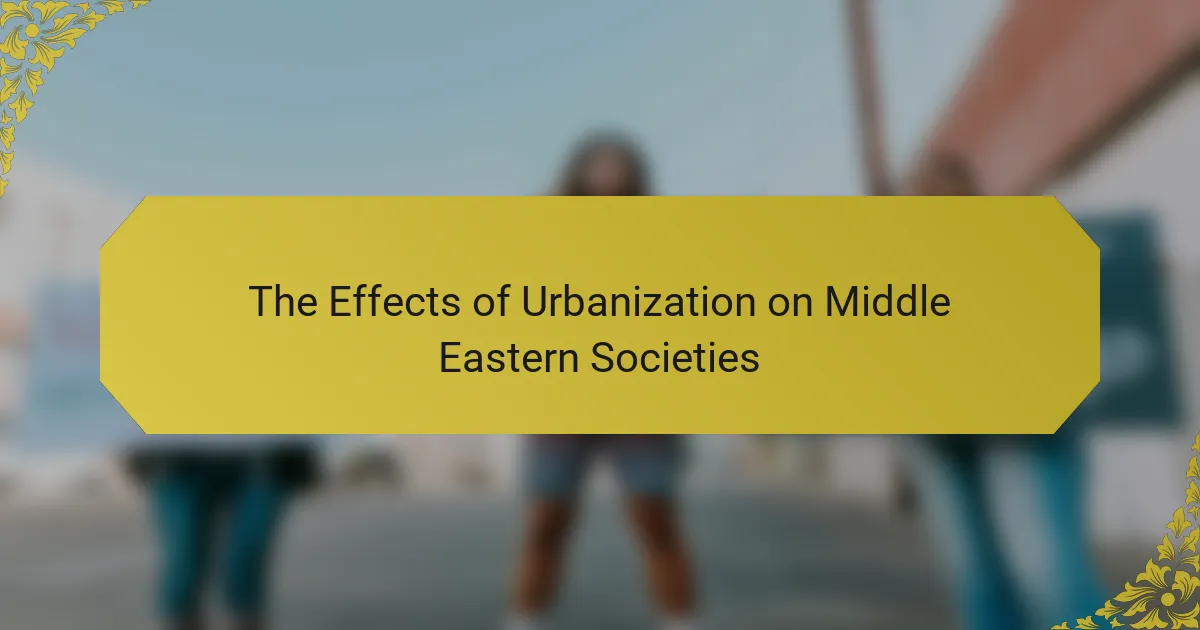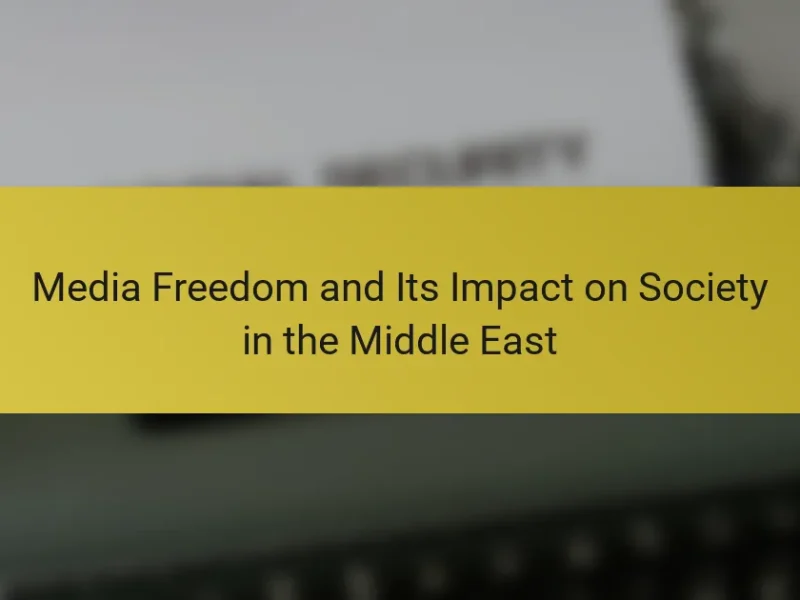
What are the Effects of Urbanization on Middle Eastern Societies?
Urbanization significantly impacts Middle Eastern societies in various ways. It leads to increased migration from rural areas to cities. This shift contributes to population growth in urban centers. Urbanization often results in economic development and job creation. Cities become hubs for trade and industry, attracting investment. However, rapid urbanization can strain infrastructure and services. It may cause housing shortages and increased living costs. Additionally, urbanization can lead to cultural shifts and changes in social dynamics. These transformations can challenge traditional values and lifestyles within communities.
How does urbanization impact cultural dynamics in the Middle East?
Urbanization significantly alters cultural dynamics in the Middle East. It leads to increased migration from rural to urban areas. This shift results in cultural blending as diverse populations interact. Traditional practices often adapt or diminish in urban settings. New cultural expressions emerge, influenced by globalization. Urban centers become hubs for modern education and technology. This fosters innovation while challenging established norms. The youth increasingly embrace global cultural trends, impacting local traditions. Overall, urbanization reshapes identities and community interactions in the region.
What changes occur in traditional practices due to urbanization?
Urbanization significantly alters traditional practices in Middle Eastern societies. It leads to the decline of communal activities, as urban settings prioritize individualism. Traditional crafts often diminish due to mass production and globalization. Family structures shift, with nuclear families becoming more common than extended families. Urbanization also changes dietary habits, with fast food replacing traditional meals. Rituals and festivals may become less frequent or commercialized. Access to modern technology influences communication styles, reducing face-to-face interactions. Finally, urbanization often results in a loss of cultural heritage as younger generations adopt urban lifestyles.
How does urbanization influence social interactions among communities?
Urbanization significantly influences social interactions among communities by altering the structure and dynamics of social networks. As populations move to urban areas, people often encounter diverse groups, leading to increased interactions across cultural and social boundaries. This diversity can foster new relationships and networks. Urban environments typically provide more social spaces, such as parks and cafes, which encourage community engagement.
Moreover, urbanization can lead to a sense of anonymity, which may reduce traditional community ties. Studies show that urban residents often have weaker social connections compared to those in rural areas. This phenomenon can result in increased isolation for some individuals. However, urban settings also facilitate the formation of new community organizations and social movements.
Research indicates that urbanization can create opportunities for collaboration and collective action. For instance, cities often serve as hubs for social activism, where individuals unite for common causes. Overall, urbanization reshapes social interactions by creating both opportunities for connection and challenges to traditional community bonds.
What economic effects does urbanization have on Middle Eastern countries?
Urbanization in Middle Eastern countries leads to significant economic effects. It drives industrial growth by concentrating labor and resources in urban areas. This concentration enhances productivity and economic output. Urbanization also increases demand for goods and services, stimulating local economies. Additionally, it attracts foreign investment due to improved infrastructure and market access.
However, rapid urbanization can strain public services and infrastructure. This often results in challenges such as housing shortages and increased unemployment rates. According to the World Bank, urban areas in the Middle East contribute over 80% of GDP. This highlights the importance of urbanization for economic development in the region.
Furthermore, urbanization can exacerbate income inequality and social tensions. Disparities in access to resources may arise between urban and rural populations. Overall, urbanization significantly shapes the economic landscape of Middle Eastern countries.
How does urbanization contribute to job creation in urban areas?
Urbanization contributes to job creation in urban areas by increasing economic activities and attracting investments. As populations move to cities, demand for goods and services rises. This demand leads to the establishment of new businesses. In urban areas, industries such as retail, construction, and technology flourish. According to the World Bank, urban areas generate 80% of global GDP. Additionally, urbanization fosters innovation and entrepreneurship. Cities provide access to a skilled workforce and resources. These factors create diverse employment opportunities. Ultimately, urbanization drives economic growth and job creation in urban environments.
What are the challenges of urbanization on economic inequality?
Urbanization presents significant challenges to economic inequality. Rapid urban growth often leads to increased disparities in wealth and access to resources. Urban areas attract diverse populations, which can exacerbate competition for jobs and housing. High demand for affordable housing results in increased living costs, pushing low-income residents to marginalized areas. This segregation limits access to quality education and healthcare, further entrenching inequality. Additionally, urbanization can create a divide between skilled and unskilled labor, leading to wage disparities. A study by the World Bank indicates that urbanization can increase income inequality in developing regions by 30%. These factors collectively illustrate how urbanization challenges economic equality.
How does urbanization affect the environment in the Middle East?
Urbanization significantly impacts the environment in the Middle East. It leads to increased air pollution due to higher vehicle emissions and industrial activities. Rapid urban growth often results in habitat destruction, threatening local biodiversity. Water resources become strained as urban areas expand, leading to over-extraction of groundwater. Urbanization also contributes to the urban heat island effect, raising local temperatures. Waste management challenges arise with higher population densities, increasing landfill use and pollution. According to the World Bank, cities in the Middle East are among the most water-stressed globally, highlighting the environmental pressures of urbanization.
What environmental challenges arise from rapid urban growth?
Rapid urban growth leads to significant environmental challenges. These challenges include increased air pollution due to higher vehicle emissions and industrial activities. Water scarcity becomes critical as urban areas consume more water than available resources can sustain. Waste management issues arise from the generation of large amounts of solid waste, often exceeding the capacity of existing systems. Urban heat islands develop, raising local temperatures and impacting energy consumption. Habitat loss occurs as natural areas are converted into urban spaces, threatening biodiversity. Soil degradation happens due to construction and increased impervious surfaces, affecting water infiltration. Flooding risks increase as urbanization alters natural drainage patterns, leading to more frequent and severe flooding events. These environmental challenges are exacerbated in Middle Eastern societies where rapid urbanization is particularly pronounced.
How is urbanization linked to resource management issues?
Urbanization is linked to resource management issues through increased demand for water, energy, and land. Rapid urban growth leads to higher consumption rates of these resources. This heightened demand often outpaces supply, causing shortages. In the Middle East, for instance, urban areas face severe water stress. According to the World Bank, many cities in the region have inadequate water management systems. Inefficient resource allocation exacerbates these challenges. Additionally, urbanization can lead to environmental degradation, impacting resource sustainability. Urban sprawl often encroaches on agricultural land, reducing food production capacity. These factors collectively illustrate the complex relationship between urbanization and resource management issues.
What role does government policy play in managing urbanization effects?
Government policy plays a crucial role in managing the effects of urbanization. It shapes infrastructure development, land use, and housing regulations. Policies can promote sustainable urban growth and mitigate environmental impacts. For instance, zoning laws can control urban sprawl and protect green spaces. Additionally, transportation policies can improve mobility and reduce congestion. Effective policies can enhance public services like healthcare and education in urban areas. Historical examples show that cities with proactive urban policies experience better quality of life. In contrast, neglecting policy can lead to overcrowding and inadequate services. Thus, government action is essential in addressing urbanization challenges.
How do urban planning strategies address the challenges of urbanization?
Urban planning strategies address the challenges of urbanization by creating structured frameworks for sustainable development. These strategies incorporate land use planning, transportation systems, and public services to accommodate growing populations. For instance, mixed-use developments promote efficient land use and reduce reliance on cars. Infrastructure improvements enhance accessibility and connectivity within urban areas. Additionally, green spaces are integrated to improve environmental quality and public health. Data from the United Nations indicates that urban planning can lead to a 30% reduction in urban sprawl. Effective urban planning also prioritizes affordable housing to combat homelessness and overcrowding. Overall, these strategies are essential for fostering resilient urban environments amid rapid urbanization.
What policies have been successful in mitigating negative impacts?
Sustainable urban planning policies have been successful in mitigating negative impacts of urbanization in Middle Eastern societies. These policies focus on integrating green spaces and promoting public transportation. For example, cities like Dubai have implemented regulations for sustainable building practices. Such regulations have reduced energy consumption and improved air quality. Additionally, investment in public transit systems has decreased traffic congestion. Research from the World Bank indicates that these policies enhance urban resilience. They help communities adapt to climate change and reduce vulnerability. Overall, these successful policies demonstrate the importance of strategic urban development in the region.
How does urbanization influence migration patterns within the Middle East?
Urbanization significantly influences migration patterns within the Middle East by creating economic opportunities in urban areas. As cities expand, they attract individuals seeking jobs, education, and improved living standards. This trend is evident in countries like Saudi Arabia and the UAE, where urban centers have experienced rapid growth. According to the World Bank, urban areas in the Middle East are expected to accommodate over 80% of the region’s population by 2050. Additionally, rural-to-urban migration is driven by factors such as conflict, climate change, and limited resources in rural regions. This shift alters demographic structures and poses challenges for urban infrastructure and services.
What factors drive rural-to-urban migration in the region?
Economic opportunities drive rural-to-urban migration in the region. Cities offer jobs that are often unavailable in rural areas. Better wages attract individuals seeking improved living standards. Access to education and healthcare services is more prevalent in urban settings. Infrastructure development in cities supports diverse economic activities. Social networks in urban areas provide support for new migrants. Environmental factors, such as droughts, also push residents to seek better conditions in cities. The combination of these factors leads to increased rural-to-urban migration in the Middle East.
How does urbanization affect the demographics of cities?
Urbanization significantly alters the demographics of cities. It leads to increased population density as people migrate from rural to urban areas. This migration is often driven by the search for better employment opportunities. Urban areas typically attract younger populations seeking education and jobs. As a result, cities experience a shift in age demographics, with a higher proportion of young adults. Urbanization also influences cultural diversity, as migrants bring various cultural backgrounds. This diversity can enhance social dynamics but may also lead to tensions. Additionally, urbanization can affect socioeconomic status distribution, often leading to increased inequality. According to the United Nations, urban areas are expected to house 68% of the global population by 2050, indicating a significant demographic shift.
What are the social implications of urbanization on Middle Eastern youth?
Urbanization significantly impacts Middle Eastern youth by altering their social structures and opportunities. It fosters increased access to education and employment, which can lead to improved economic prospects. However, urbanization also contributes to social challenges, such as rising unemployment rates among youth in cities. The migration to urban areas often results in a cultural shift, where traditional values may clash with modern lifestyles. Additionally, urbanization can exacerbate social inequalities, as not all youth have equal access to resources. According to a report by the World Bank, urban youth in the Middle East face a youth unemployment rate of 25%, highlighting the challenges they encounter. Overall, urbanization reshapes the social landscape for Middle Eastern youth, presenting both opportunities and obstacles.
How does urbanization shape educational opportunities for young people?
Urbanization significantly enhances educational opportunities for young people. It leads to increased access to schools and educational resources. Urban areas often have better infrastructure, including transportation and internet connectivity. This facilitates easier commuting to educational institutions. Additionally, urbanization attracts qualified teachers and educational professionals. The concentration of diverse populations in cities fosters a rich learning environment. Urban settings provide access to extracurricular activities and vocational training. Research indicates that urban youth are more likely to graduate from high school compared to their rural counterparts. In the Middle East, urbanization has been linked to improved educational outcomes, contributing to economic development.
What role do urban environments play in youth identity formation?
Urban environments significantly influence youth identity formation. They provide diverse cultural experiences and social interactions. These experiences shape values, beliefs, and self-perception. Urban areas often foster a sense of belonging through community engagement. Youth navigate various identities influenced by peer groups and cultural exposure. According to research, urban settings enhance opportunities for self-expression. A study by the Arab Youth Survey (2020) highlights how urban youth identify with global cultures while retaining local traditions. This duality enriches their identity and adaptability in a changing world.
What are some best practices for sustainable urban development in the Middle East?
Best practices for sustainable urban development in the Middle East include integrating green spaces into urban planning. This approach enhances air quality and provides recreational areas for residents. Implementing energy-efficient building designs is crucial. Such designs can reduce energy consumption by up to 30%. Promoting public transportation systems reduces reliance on cars, lowering greenhouse gas emissions. Utilizing renewable energy sources, like solar power, is also essential. The Middle East has abundant sunlight, making solar energy a viable option. Encouraging water conservation practices addresses the region’s water scarcity. For instance, using greywater systems can significantly reduce freshwater demand. Engaging local communities in the planning process ensures that developments meet the needs of residents. These practices contribute to a more sustainable urban environment in the Middle East.
How can cities balance growth with environmental sustainability?
Cities can balance growth with environmental sustainability by implementing smart urban planning and green technologies. Smart urban planning focuses on efficient land use and infrastructure development. This approach reduces urban sprawl and conserves natural resources. Green technologies include renewable energy sources, such as solar and wind power. These technologies lower carbon emissions and promote energy efficiency.
Additionally, cities can enhance public transportation systems to reduce reliance on personal vehicles. Efficient public transport decreases traffic congestion and air pollution. Implementing green spaces, like parks and urban forests, improves air quality and biodiversity.
Research shows that cities with integrated sustainability practices experience economic growth alongside environmental protection. For example, a study by the World Resources Institute highlights that sustainable urban initiatives can lead to a 30% reduction in greenhouse gas emissions. This evidence supports the effectiveness of balanced growth strategies in urban environments.
What community engagement strategies can enhance urban resilience?
Community engagement strategies that enhance urban resilience include participatory planning, local capacity building, and fostering social networks. Participatory planning involves involving community members in decision-making processes. This approach ensures that local knowledge and needs are integrated into urban development. Local capacity building focuses on training residents to respond to challenges. Empowered communities can better manage resources during crises. Fostering social networks strengthens connections among residents. Strong relationships can facilitate quicker responses to emergencies. Research shows that communities with high social cohesion recover faster from disasters. For instance, the UN’s “Resilient Cities” initiative highlights the importance of community involvement in urban resilience efforts.
The main entity of this article is urbanization and its effects on Middle Eastern societies. The article examines how urbanization drives migration from rural areas to cities, resulting in economic development, job creation, and cultural shifts while also presenting challenges such as infrastructure strain, housing shortages, and social inequality. It highlights the impact of urbanization on cultural dynamics, traditional practices, social interactions, economic landscapes, and environmental issues. Additionally, the article discusses the role of government policies and urban planning strategies in managing these effects and promoting sustainable urban development.


